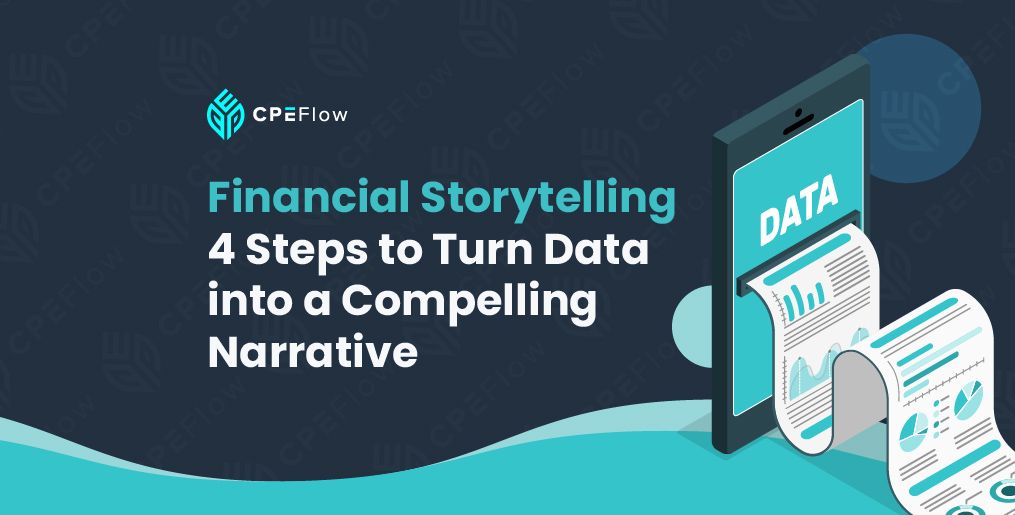The ability to transform financial data into a story sounds unnecessary. After all, you might have joined the finance team because you're great with numbers, not because you're an aspiring storyteller.
However, financial storytelling is an indispensable tool for finance professionals to drive better decision-making in their organizations. It sheds light on the "why" behind the numbers, enabling company stakeholders, leaders, and team members to understand and engage with them.
By sharpening your financial storytelling skills, you can become the bridge between data and direction. You aren't simply reporting the numbers but giving them meaning, context, and purpose. This empowers organizations to act with greater confidence and foresight.
If you want to improve this skill, check out CPE Flow's Financial Storytelling Course, where you'll learn the step-by-step process of creating an effective narrative with numbers.
Financial storytelling is the practice of transforming raw financial data into a clear, compelling narrative that explains what the numbers mean and why they matter. Instead of simply presenting results, it helps others understand the bigger picture behind the figures.
This approach is especially valuable when working with people who don't come from a finance background. It makes complex metrics more accessible, engaging, and actionable across all levels of an organization.
When done right, financial storytelling acts like a map for your business. The numbers are the coordinates. Meanwhile, the story is the map that brings everything together, showing you how you got there and where to go next.
Storytelling in finance can bring about various benefits to a company or organization. These include:
- Better decision-making: Storytelling brings context to numbers, enabling leaders to make proactive decisions with greater confidence and direction.
- Faster issue resolution: When risks or issues are clearly explained in a digestible way, teams can respond quickly and take meaningful action.
- Strategic alignment: Transforming data into actionable insights ensures that everyone, from finance to operations to the C-suite, is on the same page and moving in the same direction.
- Stronger engagement: When financial results are communicated clearly, key stakeholders and leaders are more likely to pay attention, understand, and support the next steps.
Get Exclusive Access & Special Discounts!
Get early bird access to new CPE courses and exclusive discounts only shared with our email subscribers.
Here is a step-by-step guide to crafting a financial story that will drive better decision-making across your organization.
The first step in financial storytelling is identifying which pieces of data truly matter.
Including every data point in your presentation can overwhelm your audience and dilute your message. Instead, focus on extracting the key observations that support the story you want to tell.
Your goal isn't to report every figure—it's to highlight the insights that drive action. This might be a drop in profit margins, a sudden spike in customer acquisition costs, or a noteworthy trend in monthly revenue.
The key is zeroing in on what's significant, building your narrative around those numbers, and delivering clear takeaways your audience will remember and act on.
Once you've identified your key insights, it's time to build a narrative that resonates with your audience. You don't want just to present the numbers. Your goal should be to connect the dots in a meaningful and actionable way for the people listening.
A presentation to the C-suite will look very different from one designed for the marketing team or operational managers. To tailor your message, consider these questions:
- What are their goals or priorities?
- What decisions will they need to make based on this information?
- How financially fluent are they?
- Why do these numbers matter to them?
You might not know everyone in the room. However, understanding the nature of the meeting and the general roles of the audience can help you make smart assumptions and adapt your tone and message accordingly.
Once you've defined your audience, you can start mapping out the structure of your message. It's always a good idea to draw your listeners in with a clear hook, such as a surprising statistic or bold statement. The goal is to spark curiosity without giving everything away upfront.
Then, decide how you can structure your message. There are two main ways to do this:
- Top-down: Start with your main message, then walk the audience through the supporting evidence and details.
- Bottom-up: Begin with background information and supporting details, then state your main message.
Finally, finish your financial storytelling session on a strong note. Recap key points, paraphrase to confirm understanding, and suggest specific next steps or action points. This will give your audience a sense of direction and position you as a valuable strategic partner.
Once your story is ready, it's time to enhance it with the right visuals. Compelling visuals can transform complex or boring data into clear and engaging insights, so this step deserves just as much attention as crafting the narrative itself.
The key here is to prioritize clarity. Slides packed with dense text, excessive numbers, or overcomplicated visuals can dilute your message. Instead, use clear headlines to communicate your main takeaway, highlight key points with bold text, and keep your wording concise.
Bullet points can help break down information into digestible pieces, while white space adds breathing room and makes your presentation look clean and professional.
When choosing charts, stick to the essentials. Line, bar, pie, and waterfall charts are commonly used in finance presentations. Also, aim for simplicity. Avoid 3D or special effects, cluttered text or labels, or too many colors, all of which can distract or confuse your audience.
Well-designed visuals make it easy for stakeholders to scan key metrics without digging through pages of raw data. The more intuitive and digestible your visuals are, the easier it will be for your audience to grasp the big picture and take meaningful action.
Even the most well-structured narrative won't have as much impact unless you can deliver it confidently. Practicing your presentation is where everything comes together, but it's a step that many finance professionals tend to overlook.
Rehearsing allows you to internalize your message, get comfortable with the data, and spot any unclear sections before you're in front of an audience. Aim to run through your presentation at least once beforehand, ideally out loud, to get a feel for your pacing and flow.
As you practice, don't just focus on what you're saying but also on how you're saying it. Your tone of voice, pace, and body language contribute to how your message lands. Stand or sit with confidence, make eye contact, and use hand gestures or vocal emphasis to highlight key points.
It's also normal to feel some nerves before a presentation. What's important here is how you manage this stress. Preparation is your best bet. You don't want to just memorize lines but become comfortable enough to deliver your material clearly and confidently.
Financial storytelling isn't a bonus. It's an indispensable skill that every finance professional or accountant should have if they want to drive real growth in their organization.
Financial storytelling empowers you to deliver the bigger picture to your audiences, giving decision-makers the confidence and insight they need to act strategically.
This course is designed for finance professionals who want to transform data into a clear, engaging story that inspires action. You'll learn all four key steps in depth—from extracting impactful insights to structuring your message, designing compelling visuals, and delivering it with confidence.
What's even better is that this course is entirely online and designed to fit around your day. You can work through the lessons at your own pace and from the comfort of your home, all while earning CPE credits!

Nathan Liao, CMA
Empty space, drag to resize
Nathan Liao, a Certified Management Accountant, educator, and influential business figure in the accounting industry, has dedicated over a decade to supporting more than 82,000 accounting and finance professionals in their pursuit of the CMA certification. As the visionary founder of CMA Exam Academy and CPE Flow, Nathan is committed to delivering premier online training solutions for the next generation of accounting and finance professionals.


